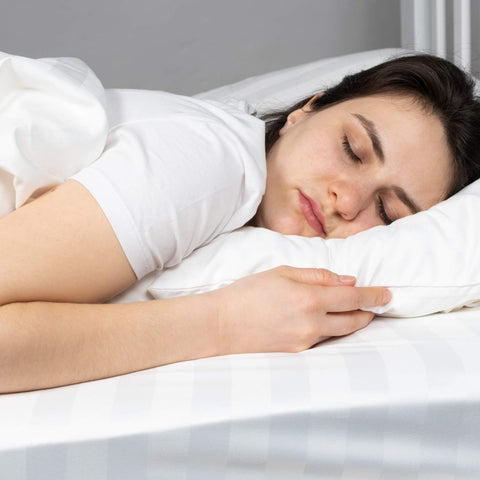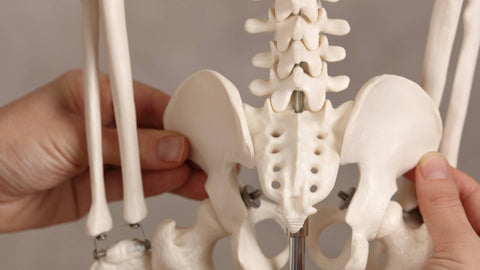Knee pain while sleeping on your side can be frustrating and disruptive to your rest. This discomfort often stems from increased pressure on your joints in this position, especially if you have an underlying condition like osteoarthritis or bursitis. Your sleep environment, particularly your mattress, plays a crucial role in managing nighttime knee pain.
Poor sleep posture and an unsupportive mattress can exacerbate existing knee issues or create new ones. When you lie on your side, your body weight concentrates on your hips and shoulders, potentially misaligning your spine and putting stress on your knees. This pressure can lead to pain, stiffness, and discomfort that worsens throughout the night.
Fortunately, there are several ways to address knee pain while side sleeping. Adjusting your sleep position, using supportive pillows, and ensuring your mattress provides adequate pressure relief can make a significant difference. Additionally, treating any underlying conditions and maintaining good sleep hygiene can help reduce nighttime knee pain and improve your overall sleep quality.
Understanding Knee Pain and Its Causes
Knee pain can stem from various factors, ranging from everyday wear and tear to specific medical conditions. Identifying the root cause is crucial for effective treatment and prevention.
Anatomy of Knee Discomfort
Your knee is a complex joint that bears significant weight and stress during daily activities. It consists of bones, cartilage, ligaments, and tendons. Cartilage cushions the joint, while ligaments provide stability.
When you sleep on your side, pressure on the knee can increase, potentially causing discomfort. This position may compress the joint, reducing blood flow and exacerbating existing issues.
Osteoarthritis, a common cause of knee pain, occurs when cartilage breaks down. This leads to inflammation, stiffness, and pain, especially when the joint is under pressure.
Common Conditions Leading to Pain
Several conditions can cause knee pain while sleeping on your side. Bursitis, inflammation of the fluid-filled sacs that cushion your joints, can be aggravated by side-sleeping.
Runner's knee, characterized by pain around the kneecap, may worsen in certain positions. A torn meniscus or ligament tears can also cause discomfort, particularly when the knee is bent.
Rheumatoid arthritis and gout are inflammatory conditions that can lead to persistent knee pain. Overuse injuries, such as tendinitis, may flare up at night due to decreased movement.
Bone spurs, degenerative changes, and Osgood-Schlatter disease in younger individuals can contribute to nighttime knee pain. Identifying these conditions is key to finding appropriate relief.
The Impact of Sleep Position on Knee Pain
Sleep position plays a crucial role in knee pain experienced during the night. Your sleeping posture can either alleviate or exacerbate knee discomfort.
Side Sleeping and Knee Stress
Side sleeping can put significant pressure on your knees. When you lie on your side, the top leg tends to drop forward, twisting the knee joint and potentially causing pain.
This position can strain the ligaments and muscles around the knee, leading to discomfort. If you have existing knee issues, side sleeping may worsen symptoms.
To reduce knee stress while side sleeping, try placing a pillow between your knees. This helps maintain proper alignment of your hips and spine, reducing pressure on your knees.
Optimizing Sleep Posture for Knee Health
Adjusting your sleep posture can greatly improve knee comfort. A supportive mattress is essential for maintaining proper body alignment and reducing joint stress.
Consider using a medium-firm mattress that provides adequate support without being too hard. Memory foam or latex mattresses can help distribute your weight evenly, reducing pressure points on your knees.
If you prefer side sleeping, try slightly bending your knees and placing a pillow between them. This position helps maintain spine alignment and reduces knee strain.
Back sleeping is often recommended for knee pain relief. Place a small pillow under your knees to maintain a natural curve in your lower back and reduce stress on your knee joints.
Pain Management and Treatment Options
Managing knee pain while sleeping on your side involves a combination of medical interventions and lifestyle adjustments. These approaches aim to reduce discomfort and improve sleep quality.
Medical Interventions for Relief
Over-the-counter pain relievers like acetaminophen, naproxen, or ibuprofen can help manage nighttime knee pain. Consult your doctor about appropriate dosages and frequency of use. Anti-inflammatory medications may be prescribed for more severe cases.
For persistent pain, your doctor might recommend corticosteroid injections to reduce inflammation. Physical therapy can strengthen muscles around the knee, improving support and reducing pain. In some cases, arthroscopic surgery may be necessary to repair damaged cartilage or ligaments.
Consider knee braces for added support while sleeping. These can help stabilize the joint and reduce pressure on painful areas.
Lifestyle Adjustments and Remedies
Apply heat or cold therapy before bed. A warm compress can relax muscles and increase blood flow, while cold packs can numb pain and reduce swelling. Experiment to see which works best for you.
Engage in low-impact exercises like swimming or using an elliptical machine to strengthen knee muscles without excess strain. Gentle stretching or yoga before bed can improve flexibility and reduce stiffness.
Try massage or relaxation techniques to ease muscle tension around the knee. Adjust your sleeping position using pillows for support. Place a pillow between your knees to align your hips and reduce pressure on the joint.
Consider lifestyle changes like weight management to reduce stress on your knees. Proper nutrition and hydration can also support joint health and reduce inflammation.
Lifestyle Factors Influencing Nighttime Knee Pain
Your daily habits and choices can significantly impact knee pain during sleep. Diet and physical activity levels play crucial roles in joint health and nighttime discomfort.
Diet and Its Effect on Joint Health
Your food choices can influence knee pain at night. A diet high in inflammatory foods may increase uric acid levels, potentially leading to gout and nocturnal knee pain. To reduce inflammation, focus on anti-inflammatory foods like fatty fish, nuts, and leafy greens. Stay hydrated by drinking plenty of water throughout the day.
Limit caffeine intake, especially in the evening, as it can affect sleep quality and potentially exacerbate knee discomfort. Consider adding foods rich in omega-3 fatty acids and vitamin D to support joint health. Maintaining a healthy weight through proper nutrition can also alleviate pressure on your knees.
The Role of Physical Activity and Rest
Balancing physical activity and rest is crucial for managing nighttime knee pain. Regular exercise strengthens the muscles supporting your knees, reducing strain during sleep. Low-impact activities like swimming or cycling can be particularly beneficial.
Avoid overexertion, as it may lead to knee swelling and increased pain at night. If you experience foot pain, address it promptly to prevent compensatory stress on your knees. Incorporate gentle stretching exercises before bed to improve flexibility and circulation.
Ensure your bedroom environment promotes quality sleep. Use a supportive mattress and pillows to maintain proper alignment. If noise disrupts your sleep and increases awareness of knee pain, consider using white noise or earplugs.



